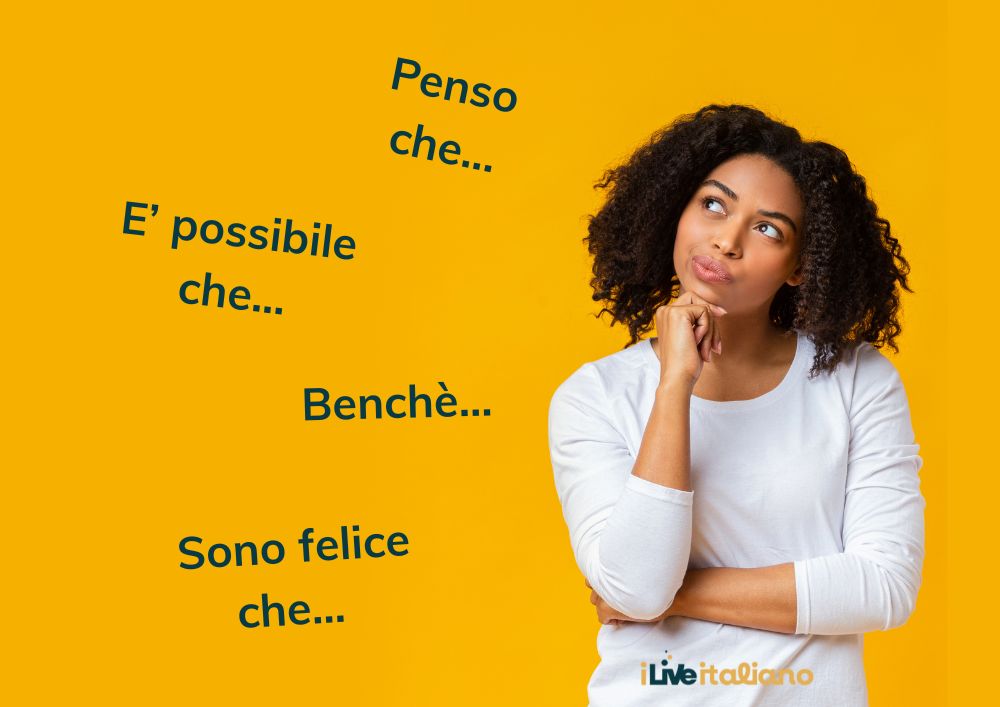The Italian subjunctive (congiuntivo) is one of the most fascinating and fearedparts of the language. But with the right explanations, it becomes much more intuitive than you might think. In this guide, you’ll learn what it is, when to use it, how to conjugate it, and how to recognize it in real-life Italian.
What is the Italian subjunctive?
The subjunctive is a mood (not a tense) that Italians use to express:
- opinions
- feelings
- doubt or uncertainty
- hopes and wishes
- possibilities
In other words, anytime you talk about something that is not certain, the subjunctive might be involved.
You will most often find it after che and inside a dependent clause.
Example:
Penso che sia una buona idea.
(I think it’s a good idea.)
Italian Subjunctive: when to use it
To know when you need the subjunctive, look at the main clause, the part of the sentence that can stand alone.
If the main clause expresses:
Opinions or beliefs
- Penso che… (I think that)
- Credo che… (I believe that)
- Immagino che… (I imagine that)
Doubts or uncertainty
- Non sono sicuro che… (I’m not sure that)
- Dubito che… (I doubt that)
Feelings or emotions
- Sono felice che… (I’m happy that)
- Mi dispiace che… (I’m sorry that)
Wishes or desires
- Spero che… (I hope that)
- Voglio che… (I want that)
Impersonal expressions
- È importante che…
- È possibile che…
- È meglio che…
All of these are subjunctive triggers.
EXAMPLE:
Voglio che tu venga con me.
(I want you to come with me.)
IMPORTANT:
You use the subjunctive only when the two clauses have different subjects.
- Penso che Maria sia stanca. → different subjects → subjunctive
- Penso di essere stanco. → same subject → infinitive, not subjunctive
Italian Subjunctive: How to Conjugate It
Here’s the essential version for everyday conversation: the present subjunctive (congiuntivo presente).
Regular verbs
-ARE (parlare)
io parli
tu parli
lui/lei parli
noi parliamo
voi parliate
loro parlino
-ERE (credere)
io creda
tu creda
lui/lei creda
noi crediamo
voi crediate
loro credano
-IRE (partire)
io parta
tu parta
lui/lei parta
noi partiamo
voi partiate
loro partano
Irregular stars you must know
- essere → sia
- avere → abbia
- andare → vada
- fare → faccia
- dire → dica
- potere → possa
- volere → voglia
- dovere → debba
- stare → stia
- tenere → tenga
If you memorize these, 80% of your subjunctive problems disappear.
Common phrases and triggers with the Italian subjunctive
Here are expressions you will hear every day:
| Italian Trigger | English |
| penso che | I think that |
| credo che | I believe that |
| spero che | I hope that |
| voglio che | I want that |
| ho paura che | I’m afraid that |
| è possibile che | it’s possible that |
| è importante che | it’s important that |
| benché / sebbene | although |
Real-Life examples and conversations
Example 1
Italian: Penso che tu abbia ragione.
English: I think you’re right.
Example 2
Italian: Spero che domani non piova.
English: I hope it doesn’t rain tomorrow.
Example 3
Italian:
– Giovanni viene alla festa?
– Non sono sicura che possa venire.
English:
– Is Giovanni coming to the party?
– I’m not sure he can come.
Italian subjunctive: tips to master it
Listen more than you study
The subjunctive becomes intuitive the more you hear Italians use it.
Learn the triggers first
If the main clause expresses emotion, doubt or opinion… your brain should ring an alarm: “Subjunctive!”
Start with the present tense
It’s the most used—and the easiest.
Don’t panic about mistakes
Even Italians mess it up…and joke that “chi usa bene il congiuntivo è più sexy.”
(Those who use the subjunctive well are sexier!)
Practice with short sentences
Penso che sia…
Credo che tu abbia…
Spero che vada…
Italian Subjunctive – FAQ
Here are quick answers to the most common questions.
Is the Italian subjunctive difficult to learn?
It can feel tricky at first, but once you learn the main triggers and the basic conjugations, it becomes much more natural, especially if you listen to real Italian often.
Is the Italian subjunctive used in everyday conversation?
Yes, especially in educated spoken Italian. Some speakers use the indicative instead, but the subjunctive is still considered the correct and more elegant choice.
When NOT to use the subjunctive in Italian?
When the sentence expresses certainty:
È certo che…
È ovvio che…
È evidente che…Or when the two clauses have the same subject.
What triggers the subjunctive in Italian?
Verbs and expressions of opinion, emotion, doubt, uncertainty, desire, and impersonal expressions like è importante che…, è possibile che…
What is an example of a subjunctive in Italian?Spero che tu stia bene.
(I hope you’re doing well.)
stia → subjunctive.



